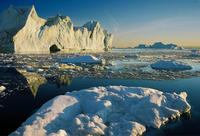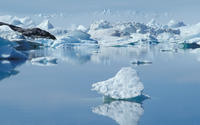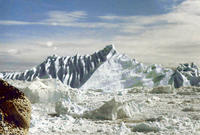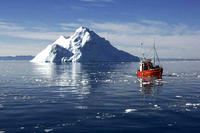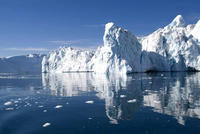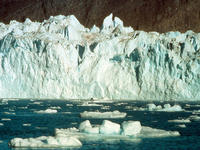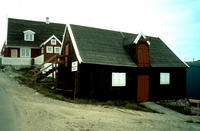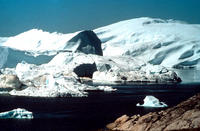You are in: Europe -> Denmark -> Ilulissat Icefjord, and traditional search or Image Gallery will yield results of this site only
Ilulissat Icefjord
| Site number: | 1149 |
|
| Type of site: | Natural | |
| Date of Inscription: | 2004 | |
| Location: | Europe, Denmark, West coast of Greenland, Bay of Disko Bugt (bight), Municipality of Ilulissat | |
Up to 75 images are shown here. Click on each for more details or on Image Gallery for more images.
Six official UN languages:
Arabic,
Chinese,
English,
French,
Russian,
Spanish
Other languages: Danish, Dutch, Finnish, German, Greek, Hebrew, Icelandic, Italian, Japanese, Norwegian-bokmål, Norwegian-nynorsk, Portuguese, Turkish
Other languages: Danish, Dutch, Finnish, German, Greek, Hebrew, Icelandic, Italian, Japanese, Norwegian-bokmål, Norwegian-nynorsk, Portuguese, Turkish
| Description: | The Greenland’s 40,240-ha large Ilulissat Icefjord is the sea mouth of Sermeq Kujalleq (one of the few glaciers through which the Greenland ice cap reaches the sea). The Icefjord is located on Greenland’s west coast, 250-km north of the Arctic Circle. Moving 19-m per day, Sermeq Kujalleq is one of the world’s fastest, as well as the most active glaciers. The glacier annually calves over 35 cubic kilometres of ice, which is 10% of all Greenland’s calf ice creation and more than any other glacier outside Antarctica. Having been studied for over 250 years, the site has assisted in developing our understanding of icecap glaciology and climate change. The huge ice-sheet together with the vivid sounds made by the fast-moving glacial ice-stream calving within an iceberg covered fjord creates a dramatic and awe-inspiring natural phenomenon. --WHMNet paraphrase from the description at WHC Site, where additional information is available. | |
| Ilulissat is the third largest settlement in Greenland and also the seat of the municipality of Ilulissat (Ilulissat Kommuniat). The town is located about halfway up the country's west coast, and about 200 kilometres north of the Arctic Circle. Illulisat is also widely known by its Danish name of Jakobshavn ("Jacob's Harbour"). In direct translation Ilulissat is the Greenlandic word for "The Icebergs". Ilulissat is Greenland's most popular tourist destination on account of its proximity to the picturesque Ilulissat Icefjord - tourism is now the town's principal industry. Ilulissat was the birthplace of celebrated polar explorer Knud Rasmussen and his childhood home in the centre of the settlement is now a museum dedicated to him. Inuit settlements have existed in the area of the icefjord for at least three thousand years. The abandoned settlement of Sermermiut two kilometres south of the modern town of Ilulissat was once amongst the largest settlements in Greenland with around 250 inhabitants. The modern town was founded in 1741 by missionary Danish Poul Egede for trader Jakob Severin who had an established a trading lodge in the area. In 2006, ITV News' science editor Lawrence McGinty visited Ilulissat for a series about climate change called 3 degrees from disaster. The Ilulissat Icefjord (Ilulissat Kangerlua) runs west 40 kilometres from the Greenland Ice Sheet to Disko Bay close to Ilulissat town. At its eastern end is the Jakobshavn Isbræ glacier, the most productive glacier in the northern hemisphere. The glacier flows at a rate of 20-35 metres per day, resulting in around 20 billion tonnes of icebergs calved off and passing out of the fjord every year. Icebergs breaking from the glacier are often so large (up to a kilometer in height) that they are too tall to float down the fjord and lie stuck on the bottom of its shallower areas, sometimes for years, until they are broken up by the force of the glacier and icebergs further up the fjord. On breaking up the icebergs emerge into the open sea and initially travel north with ocean currents before turning south and running into the Atlantic Ocean. Larger icebergs typically do not melt until they reach 40-45 degrees north (south of the United Kingdom and level with New York City). The Ilulissat Icefjord was declared a UNESCO World Heritage Site in 2004. --Wikipedia. Text is available under the Creative Commons Attribution-ShareAlike License. | ||
| Source: | http://whc.unesco.org/en/list/1149 | |
| Reference: | 1. UNESCO World Heritage Center, Site Page. | |




